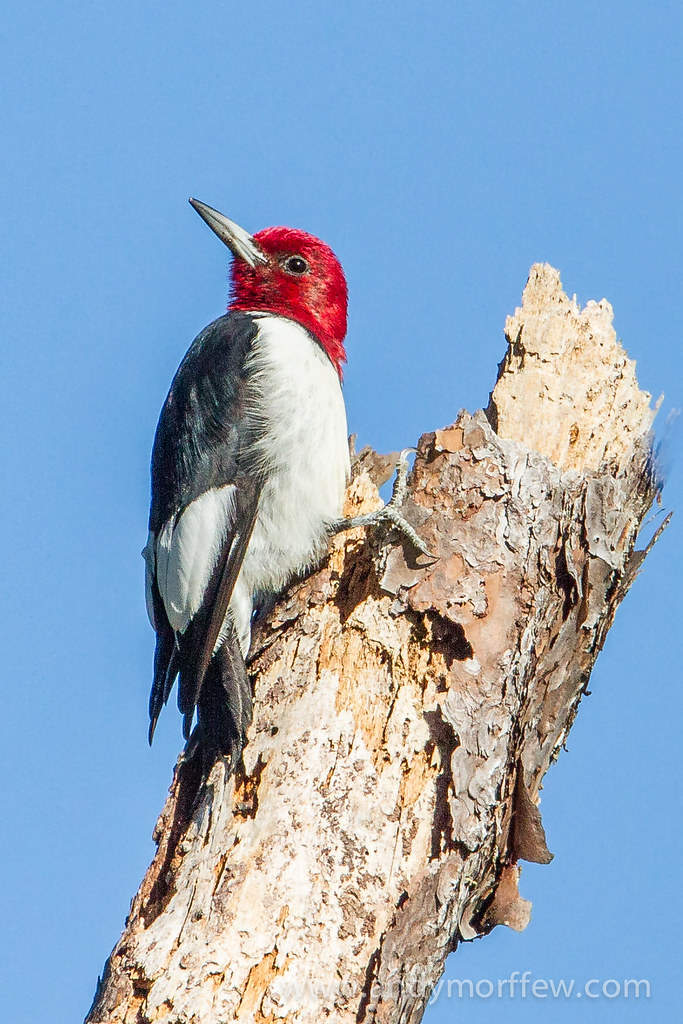Polk County’s Most Wanted – Red-headed Woodpecker (Melanerpes erythrocephalus)
Have you seen…or heard…the Red-headed Woodpecker (Melanerpes erythrocephalus)?

Conserving Carolina and botanist/ecologist David Campbell need your help in locating this month’s “Polk County’s Most Wanted—Animal,” the Red-headed Woodpecker (Melanerpes erythrocephalus). Polk County’s Most Wanted is a community science initiative with a new challenge each month, in which you can expand the scientific understanding of the flora and fauna of Polk County.
Where should I look for the Red-headed Woodpecker?
Red-headed Woodpeckers are occasional visitors of birdfeeders in the winter and they especially like suet. They will eat seeds, corn, acorns, beechnuts, pecans, and many kinds of wild and domestic fruits.
This woodpecker’s preferred habitat is open forest areas with a clear understory and numerous snags suitable for nesting and roosting. They can also be found in lowland forests, orchards, pastures, wetlands, and suburban parks with standing tree snags and widely spaced trees.
How do I identify the Red-headed Woodpecker?
The Red-headed Woodpecker is recognizable to even the most unintended bird observer. It is a small to medium-sized woodpecker with striking plumage. Adults have a brilliant red head, black back, large white wing patches, and a white belly. In addition to being colorful, like most woodpeckers, they are noisy as well! Their most common call is a hoarse, shrill tchur, similar to the call of the Red-bellied Woodpecker but higher in pitch and less rolling. Other sounds to be aware of are the drumming sounds made when woodpeckers are establishing territory. The Red-headed Woodpecker will drum on trees, utility poles and other objects that amplify the volume of their drumming. Red-headed Woodpeckers have a drumming pattern that is similar to the Downy Woodpecker, it includes a two-parted hammering sound and a disjointed roll at the end.
The Red-headed Woodpecker is one of only four woodpecker species that commonly stores, or “caches,” food in crevices, tree cavities, or under bark (the others include Acorn, Downy, and Red-bellied Woodpeckers). These caches ensure that the woodpecker has a reliable source of food year-round.
Conservation Status
Red-headed Woodpeckers were once a very common species throughout the east, but their numbers have been declining for years, and recent surveys indicate that this trend is continuing. The reasons for their decline is not well known but probably includes habitat loss caused by development of bottomland forest, suppression of fires, and loss of potential nest sites (due to cutting of dead trees). Another reason for their decline may be increased competition with other birds, particularly the non-native European Starling (Sturnus vulgaris), for nest cavities. Red-headed Woodpeckers also fall victim to being struck by cars as they foraged along roadsides for insects inflight.
The 2014 State of the Birds Watch List includes the Red-headed Woodpecker as a bird species that is at risk of becoming threatened or endangered without the help of conservation efforts, and the International Union for Conservation of Nature (IUCN) Red List has categorized the species as Near Threatened.
What can you do?
If you think that you have seen, Red-headed Woodpecker in Polk County, please contact Pam Torlina at Conserving Carolina by email at [email protected], and if you can, provide a clear photo or recording, for a definitive confirmation.
For More Information
Visit Conserving Carolina’s website, conservingcarolina.org/polk-most-wanted, for more information about “Polk County’s Most Wanted” and to download and print a “Pocket Guide” with all of the “Most Wanted” plants, animals, and habitats that you can be on the lookout for!
Also, a culmination of David Campbell’s seven years in the field documenting the rare and significant flora and fauna in Polk County have been compiled in a book titled, “An Inventory of the Significant Natural Areas of Polk County, North Carolina.” The document can be downloaded for free on Conserving Carolina’s website at conservingcarolina.org/polk-county-inventory, or a hard copy can be purchased, at cost, on Amazon.
Conserving Carolina, your local land trust, is dedicated to protecting land and water, promoting good stewardship, and creating opportunities for people to enjoy nature. Learn more and become a member at conservingcarolina.org.